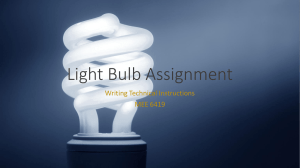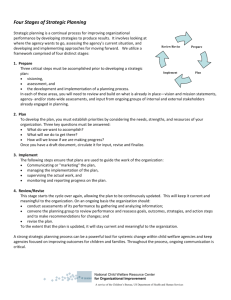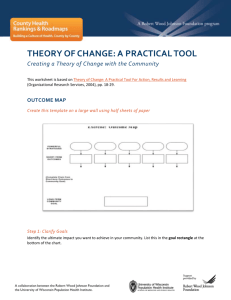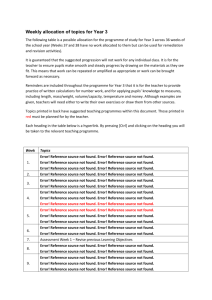Document 13525814
advertisement
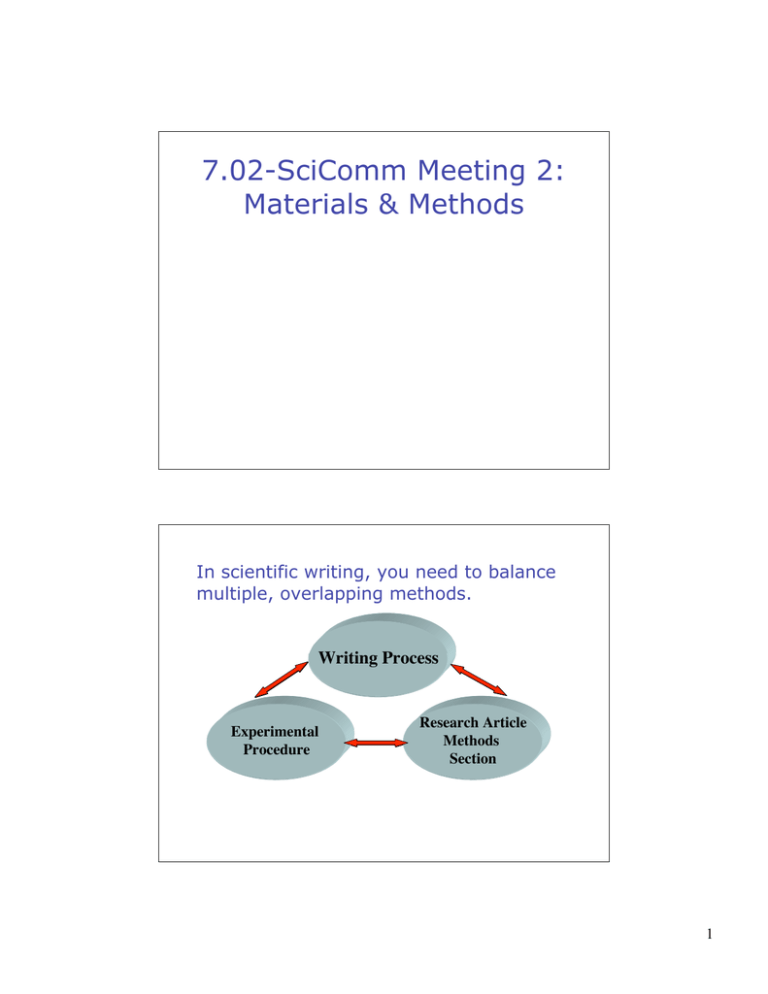
7.02-SciComm Meeting 2: Materials & Methods In scientific writing, you need to balance multiple, overlapping methods. Writing Process Experimental Procedure Research Article Methods Section 1 Modeling the writing process lets us know at what point to intervene/teach. Goals/Questions for the Writer What do I know about my topic? What is my purpose for writing? Who are my intended readers and how much do they know about my topic? How is this task like others I have had before? What structure will work best for my topic? Episode 1: Planning Episode 4: Editing Episode 2: Drafting Episode 3: Revising Effective writers are able to selfmonitor their composing strategies 1. 2. 3. Declarative Knowledge: Knowing what strategies are available Procedural Knowledge: Knowing how to use a strategy. Conditional Knowledge: Knowing how and when to use a strategy. The goal is to develop all three types of knowledge about each phase of the writing process. 2 Scientific writers need to control the rhetoric of scientific writing. According to Aristotle, rhetoric is “the art of finding in any given case the available means of persuasion.” Any writing act can be described in terms of rhetorical triangles. Writer Context Reader Text Writers balance the relationship between themselves, their texts, their readers, and the context in which this balancing act takes place. 3 More Rhetorical Triangles Purpose Audience Content Reality tends to complicate these triangles. Multiple Purposes: – – – – To explain To entertain To persuade (To get an A) Multiple Audiences: –Real reader –Imagined reader –Peers –Instructors The result can be writer’s block! 4 The research process and writing process share essential stages. Research involves: Writing involves: • Posing initial questions • Starting with an idea • Exploring questions through discovery • Exploring ideas through writing • Revising questions based on findings • Revising based on reader’s needs • Communicating • Presenting final findings to a specific product to a specific audience audience In both processes language is a tool of both discovery and communication. Writing and research are complex processes enabled by language. “Language, oral or written, is an expressive instrument through which we communicate what we have previously thought [or discovered]. It is also the reflective instrument through which we think, alone or with others, about what we are doing.” Paul Connolly 5 The goal of scientific writing is to court your audience. Michael Halloran on Watson & Crick’s 1953 “The Structure for DNA” “The April 1953 paper, then, is really just the initial move in a rhetorical strategy aimed at gaining and holding the attention of an audience. As such, it presumes an understanding of science as a human community in which neither facts nor ideas speak for themselves, and the attention of the audience must be courted.” Experienced Scientific Writers… • Seek Feedback – peer-edit – self-edit (after a long enough delay) – expert-edit • Expect to learn by writing as well as to inform. • Revise, revise, revise, revise, revise, revise, revise, , revise revise , revise, revise , revise , revise , . revise 6 Some Good Resources for Those in Need Alley, Michael. The Craft of Scientific Writing. 3rd ed. New York, NY: Springer, 1997. ISBN: 0387947663. Day, Robert A. How to Write and Publish a Scientific Paper. 5th ed. Westport, CT: Greenwood, 1998. ISBN: 1573561657. Good MIT Resources Paradis, James G., and Muriel Zimmerman. The MIT Guide to Science and Engineering Communication. Cambridge, MA: MIT Press, 2002. ISBN: 0262661276. Perelman, Leslie C., James Paradis, and Edward Barret. The Mayfield Handbook of Technical and Scientific Writing. New York, NY: McGraw Hill Higher Education, 1997. ISBN: 1559346477. The Mayfield Guide On-Line http://www.mhhe.com/mayfieldpub/tsw/home.htm The MIT Writing and Communication Center http://web.mit.edu/writing/ Appointment preferred but not required 7 What are Some Goals of a Methods Section? • Present the experimental design. • Provide enough detail to allow readers to interpret your results. • Give enough detail for readers to replicate your work. Matthews, Janice R. et al. Successful Scientific Writing Full Canadian Binding: A Step-by-Step Guide for the BioloPressgical and Medical Sciences. Cambridge, UK: Cambridge University, 2000. ISBN: 0521789621. According to Paradis and Zimmerman, “The experimental [or methods] section of an article describes the tools and processes that enabled you to meet the stated objectives of the introduction. . . . This section will be read for at least two major reasons. First, readers will judge how skillfully you have designed the empirical process of problem solving. Second, readers may test your methodology against your results in their own laboratories. In experimental sections, clarity and accuracy are priorities.” 8 What are some pitfalls of a Methods section? • Providing too little or too much information. • Reiterating published methods rather than citing them. • Writing strictly in chronological order (alternatives: most important first, most fundamental first, etc.). • Methods and results don’t correspond (you have to provide methods for all the experiments you report). • Forgetting to use visual organizers that direct readers to specific aspects of the methods section, e.g., subheads. Pitfalls of a Methods Section, cont. • Using a “dangling modifier” because of an overreliance on passive voice: Watch out for the dangler! “After scraping the desired plate in four swipes, the bacteria were placed in 8ml of media with no antibodies.” • Failing to provide a context and reasons for the methods themselves: “In order to . . . , we . . . “ ⇐ context for the particular method is provided. • Writing a Protocol rather than a Methods section. 9 Protocol vs. Methods Section A Protocol is . . . • A series of steps to be carried out. • Written in sequential or temporal order. • Intended for the reader to achieve a final result. A Methods Section is . . • A series of steps already completed and is written in past tense. • Written in logical order. • Intended for the reader to replicate the experiment. Section headings: descriptive and parallel Non-Parallel Non-Descriptive Parallel Descriptive Introduction Background Marx Generators Line Pulse Beam Generation Transporting Beam Pellets Results Conclusions Introduction Past Designs for Particle Beam Fusion New Design for Particle Beam Fusion Charging Marx Generators Forming Line Pulse Generating Particle Beam Transporting Particle Beam Irradiating Deuterium-Tritium Pellets Results of New Design Conclusions and Recommendations 10 Use Section Hierarchies to Clarify Structure Performance of the Solar One Receiver Performance of the Solar One Receiver Introduction Steady State Efficiency Introduction Receiver’s Efficiency Steady State Efficiency Average Efficiency Start-Up Time Operation Time Operation During Cloud Transients Panel Mechanical Supports Tube Leaks Conclusion Average Efficiency Receiver’s Operation Cycle Start-Up Time Operation Time Operation During Cloud Transients Receiver’s Mechanical Wear Panel Mechanical Supports Tube Leaks Conclusion Bad vs. Good Genetics Methods Examples (from KBS) 1 ml of an overnight culture of E. coli bacteria was inoculated into 50ml of LB or M9 media and grown at 37˚C for 4 hours in a New Brunswick Scientific water bath. At regular intervals, 1 ml of culture was removed from the flask using sterile technique (flaming tubes, flasks, and tips) and placed on ice. The OD550 was taken of each sample in a Milton Roy Spectronic 601 spectrophotometer blanked with medium alone. Additionally, a set of serial dilutions of each sample was made in saline. Diluted samples were plated on LB plates and grown overnight at 37˚C. Generation of Bacterial Growth Curves. 1 ml of an overnight culture of BW140 E. coli bacteria was inoculated into 50ml of LB (or 4 ml of culture into 50 ml of M9 media) and grown at 37˚C for 4-2.5 hours with shaking. in a New Brunswick Scientific water bath. At regular 30 minute intervals, 1 ml of culture was removed from the flask using sterile technique (flaming tubes, flasks, and tips) and placed on ice. The OD550 was taken of each sample in a Milton Roy Spectronic 601 spectrophotometer blanked with medium alone. Additionally, a set of serial dilutions (10-1, 10-2, 10-3, 10-4, 10-5, 10-6) of each sample was made in saline.Diluted 100 µl of the 10-4, 10-5, and 10-6 samples were plated on LB plates and grown overnight at 37˚C. Colonies were counted, and used to create two graphs on semi-log paper: OD550 vs. time and cfu/ml vs. time. 11 Methods Sections for Your LongTerm Projects • For the 7.02 Experience - Describe your methods of learning and how you will measure achievement: – e.g., attending lecture, recitation, laboratory, writing prelabs, studying for exams, meeting with your lab partner, study groups, background reading, etc. • For the Mendel Paper - Describe: – – – – – Plant selection Growth conditions Monohybrid crosses Dihybrid crosses Data analysis Today’s In-Class Exercises Responding to a peer’s Long-Term Project Introduction: – The peer you should respond the person who posted his/her LTP Introduction immediately BEFORE yours. – Your response should be in the form of a file attached as a reply to your peer’s message. – Feel free to use inserted comments or Track Changes to comment within the text, but also offer summary comments. 12 Effective Peer Review Examples Responding as a reader • This last sentence is very long. By the end I am not even sure what the goal of your study is. Try to separate it into clear separate points to let the reader know what exactly you are focusing on. • I am not able to put my finger on the thesis but I can very easily understand the point of your essay. The reader needs more background on you though, since even though it is science related this is also somewhat of a personal essay. • odd wording and also you made no reference to WHAT you want to do. The next part talks about research, do you want to do something in addition to research? Tell the reader more about why this is useful to whatever your planned career is. More Effective Peer Review Examples Stress the positive, as well as the potential for change • Overall I thought your intro was structured well. It gave enough background info that was well cited, then narrowed the focus to a specific aspect of the mechanisms of the disease and the proteins/ other components that were involved. Then you made sure to state past research, the research to be done and the effect this would have on the field overall. The only problems I had was the wording in a few places. • This is a good introduction to you as a learner, but I think that you might add a sentence or two on what exactly your paper will be looking at. You do establish yourself very well as a inquisitive learner, but you don’t explain why you are doing this or what relevancy this will have on the following paper. Great job overall, though, you covered just about everything the assignment asked for. 13 Today’s Out-of-Class Exercises Due on the off week--by March 3, 5 p.m. • Paraphrase (suitable for a high-school senior) the introduction to the Druker et al. Chronic Myeloid Leukemia article. Send via email Remember to label your file with your name and assignment (e.g., Lerner_Druker_Intro.doc). Due by next class meeting--March 10 • Read “The Science of Scientific Writing” for class discussion. Designated students will be giving oral presentations on this article. • Write a draft of your long-term project Methods section Due by March 17, 5 p.m. • Write a brief critique (2-3 pp.) of “The Science of Scientific Writing.” • Revise, if you choose, your LTP intro. 14
